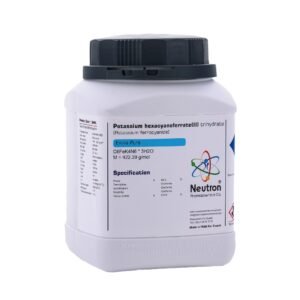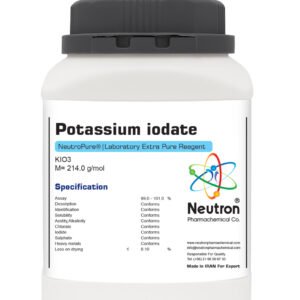آمونیاک 32%
| Formula | NH3 |
| Density | 0.88 g/cm3 (20 ºC) |
| Molar mass | 17.03 g/mol |
| CAS number | 1336-21-6 |
| HS code | 28142000 |
| EC number | 007-001-01-2 |
| Storage (temprature) | +15 ºC to +25 ºC |
| SDS | Available |
| RTECS | BQ9625000 |
| R phrase | R 34 – 50 |
| S phrase | S 26-36/37/39-45-61 |
| Odour: | pungent |
| Form: | liquid |
| Color: | colourless |
| Explosion limit: | 15.4 – 33.6 Vol% |
| Solubility in wate: | (20 ºC) soluble |
| Boiling point: | 24.7 ºC |
| Melting point: | – 91.5 ºC |
| Vapour pressure: | ~ 837 hPa (20 ºC) |
| Assay | ≥ | 30.0 | % |
| Identification | Conforms | ||
| Chloride | ≤ | 0.002 | % |
| Sulphate | ≤ | 0.003 | % |
| Heavy metals | ≤ | 0.0001 | % |
| Fe | ≤ | 0.0005 | % |
| Substances reducig potassium | ≤ | 0.0008 | % |
| permanganate | |||
| Residue on ignition | ≤ | 0.003 | % |
Ammonia solution 32% is a concentrated aqueous solution of ammonia gas, commonly used as a cleaning agent, fertilizer, and chemical reagent.
🏭⚗️ Production
Ammonia solution is produced by dissolving anhydrous ammonia gas in water under controlled pressure and temperature. Industrially, ammonia gas is generated via the Haber-Bosch process, then absorbed into water to form solutions of various concentrations, including 32%.
🔬 Properties
Ammonia solution 32% appears as a clear, colorless liquid with a pungent, irritating odor. Its chemical formula is NH₃·H₂O, and it is highly alkaline with a strong basicity. It is miscible with water and volatile due to ammonia gas release.
🧪 Applications
It is widely used as a household and industrial cleaner, fertilizer (nitrogen source), in water treatment, and as a reagent in chemical synthesis and textile processing.
⚠️ Safety
Ammonia solution 32% is corrosive and toxic. It can cause severe irritation or burns to skin, eyes, and respiratory tract. Inhalation of vapors can cause coughing and respiratory distress. Proper protective equipment such as gloves, goggles, and respirators should be used. It should be stored in well-ventilated, cool areas away from acids and oxidizers.





